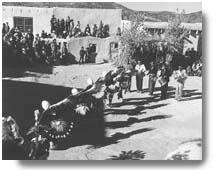Opinion: Hungry For More

The current show at the Sag Harbor Picture Gallery, "Native American Photography and the Legacy of Edward S. Curtis," has one drawback - it could be three times the size. It sucks you in, fills your mind full of ideas, and leaves you hungry for more.
This small gallery has had consistently interesting shows since it opened, and it would be great if it would invite these young Native Americans back for another go-round.
Edward S. Curtis is regarded as the greatest photographer of the American Indian. Between 1898 and 1928, in an effort to document what he perceived as a "vanishing race," he made over 40,000 negatives of 80 Indian tribes. A number of his original photogravures can be seen here, contrasted with photos of some of the same tribes taken nearly 100 years later.
Acculturation Theme
In a wonderful portrait by Curtis of an old man wearing a string of amber beads and silver jewelry called "The Story of the Washita," one can see every detail of the handmade chamois jacket with its fine bead embroidery.
On the opposite wall is an equally stirring 1991 portrait by David Neel of Agnes Alfred of the Nangis tribe, the deeply lined face almost a twin of the 1927 portrait. But in this picture the intricate pattern on her clothes is made in modern sequins and pearlized plastic buttons.
Acculturation is the theme that runs through the show. Mr. Neel's other print, "Self-Portrait With Chief Charlie Swanson," shows an old man wearing traditional robes and a wary expression. Next to him on a bench sits the photographer, camera in hand, his features similar but more cynical, dressed in a white T-shirt with a gaudy Indian pattern on the front.
Spare And Elegant
More subtle is Dorothy Grandbois's seven-frame portrait of Tom Toslino, possibly an antecedent. In the first frame he is in tribal costume with long hair and earrings. The second frame shows him after he had been enrolled in a boarding school, transformed into a mock European in a tight-fitting Victorian suit and close-cropped hair. The subsequent computer-enhanced frames show this second portrait gradually fading.
The work is spare, elegant, and absolutely on target emotionally. Ms. Grandbois is a member of the Turtle Mountain Band of North Dakota Chippewa.
Lee Marmon of Laguna Pueblo has some fine portraits, as does John Lukas, whose "Treaty Meetings, Rosebud Reservation," is a joy. On the left an out-of-focus face smokes a cigarette while center frame another old man shields his eyes with a meshed Panama hat against the sun, casting an intricate pattern across his face.
Mr. Lukas manages to say a hell of a lot with his simple, laconic shots - "Oglala, South Dakota" is just a photo of a wood stove, but its sad enamelware and cracked, unwashed tiles speak loudly of joylessness and lack of hope.
In the witty "Odd House," two wooden privies marked in rough black letters "Men" and "Women" stand at the extreme edges of the frame. Between them, on the horizon, rises a mountain. But it's not so distant as the gap between those two little huts. Nice show. More please.
